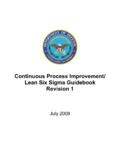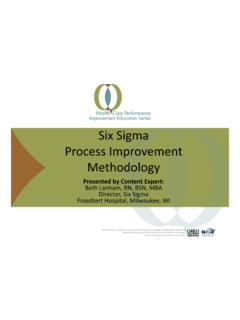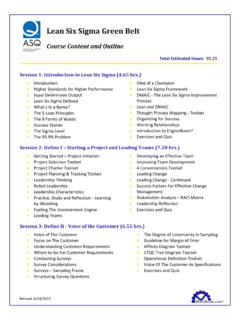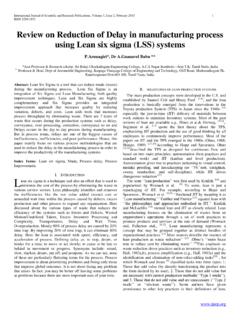Transcription of The Impact of Lean Six Sigma on the Overall …
1 The Impact of lean Six Sigma on the Overall results of companies Corina DUMITRESCU1 Marilena DUMITRACHE2 ABSTRACT lean Six Sigma represents a management approach for driving innovating processes inside a company in order to achieve superior results . It involves a practical analysis based on facts, aiming the innovation and growth, not only the efficiency of processes. It is a long term process of gradual and continuous improvement. The application of lean Six Sigma in companies led to attaining superior financial performance by addressing new needs, by differentiating the products and services or by adjusting the business lines to new processes.
2 Quality is more than making things without errors. It is about making a product or service meet the individual perception of a customer about the quality or value. Therefore, in what regards lean Six Sigma , the concern is not only to "do the things right" but also to "do the right things right". We focus on the Impact of implementing the lean Six Sigma approach on companies , seeking for what changes and benefits it brings. The key elements it aims at are achieving the best quality, the lowest cost, getting the shortest lead-time, stressing on waste elimination.
3 The requirements of a company for its implementation and the strategy to obtain the maximum practical outcome are investigated. Furthermore, we conduct a comparison analysis with the other methods of the total quality management and see why lean Six Sigma is a more desirable approach. KEYWORDS: lean Six Sigma , fact-based analysis, innovation, strategy, quality, gradual and continuous process JEL CLASSIFICATION: O31, P12, M11, L23, L25 INTRODUCTION Competition has become more and more fierce, customers are demanding higher quality at lower prices and profit margins seem to be falling especially in times of crisis.
4 An efficient and effective strategy to become more competitive is to adopt lean Six Sigma . Quality is more than making things without errors. It is about making a product or service meet the individual perception of a customer about the quality or value. Therefore, in what regards lean Six Sigma , the concern is not only to "do the things right" but also to "do the right things right". In the present study we focus on the key elements of lean Six Sigma , we highlight the 1 Academy of Economic Studies, Bucharest, Romania, 2 Academy of Economic Studies, Bucharest, Romania, Corina DUMITRESCU, Marilena DUMITRACHE 536 Impact of implementing the lean Six Sigma on companies , we seek to indicate the requirements of a company for its implementation and investigate the strategy to obtain the maximum practical outcome.
5 Furthermore, we conduct a comparison analysis with other methods of the total quality management and see why lean Six Sigma is a more desirable approach. 1. KEY ELEMENTS OF lean SIX Sigma Six Sigma is both a statistical measure of variation in a process and a strategy of business management, developed by Motorola in 1981, to increase quality, eliminate the root causes of defects and reduce variation and defects within its manufacturing processes. Six Sigma programs aim at improving competitive positioning and increasing the value of the company as perceived by the customer.
6 A Six Sigma process has, as a statistical quality goal, the achievement of a quality level equal to maximum defects per million opportunities for defects, which is +/- six standard deviations from the mean. As of 2006 Motorola reported over US$17 billion in savings (About Motorola University, 2006) from Six Sigma . Nowadays it is used for a variety of processes and fields of activity. It also focuses on reducing variability within a formalized project management structure. This implies the stability and the predictability of results . In fact, the management structure for executing and managing projects is a real strength of the Six Sigma approach.
7 When executed well, Six Sigma can help an organization achieve very significant improvements in quality, reduction of defects, and ultimately lower cost (Swartwood, 2003). The principles of Six Sigma (SS): Focus on customer needs; Continuous effort to reduce process variation using statistical analysis; Improvement and control of processes; Teamwork and involvement from all levels of organization, especially from top-level management. A widely accepted definition of lean manufacturing is the systematic approach to identify and eliminate waste (non value-adding activities) through continuous improvement by flowing the product at the pull of the customer in the pursuit of perfection (Brue & Howes, 2006).
8 It focuses on reducing the business cycle time so as to become more responsive to customer demand, while using less resources and improving products and processes. These materialize in lower costs, increased productivity and highly profitable and flexible production capability, Overall , an increased operational efficiency. In 1990 the lean concept becomes popular in American factories after the study by the Massachusetts Institute of Technology of the shift from mass production to a disciplined, process-focused production. The term lean refers to the cut off the fat (waste) anything bringing no added-value for a customer or something he is unwilling to pay for (Brue & Howes, 2006).
9 The aim of lean is to create simplified, efficient value-adding processes while sharing information. Successful lean initiatives yield lower inventory cost, higher productivity and flexibility, and faster response time to the customer (Subramaniam, 2007). Economia. Seria Management Volume 14, Issue 2, 2011 537 Table 1 indicates a few types of waste where lean can be applied. Table 1. lean targets Source: adapted from Brue & Howes (2006) Type of waste Content lean Target Correction Reworking and repairing Solves the following: Inadequate process control; Poor quality; Insufficient training; Poor product design; Unclear customer needs.
10 Overproduction Producing more than necessary or earlier than needed Uses process automation; Smoothes scheduling. Inventory and work in process Excess inventory Solves the following: Inefficiencies; Product complexity; Bad scheduling; Unreliable deliveries; Poor communications. Unnecessary process steps Non-value adding activities Questions every step whether it is necessary Wait Being idle between operations or while a machine is processing Maximizes the use of workers byanalyzing work load and work flow, production and maintenance schedules, sets up times and procedures Transportation Causing damage and waste of time by moving products/processes Identifies the process flow, the inefficient site layout and lead-times Motion Unnecessary, awkward.








